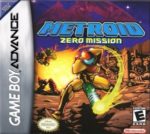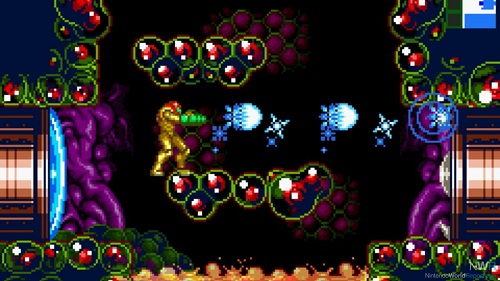Reader Review: Metroid Zero Mission: Playing My Way to Metroid Dread
 Out of the blue my younger brother Nathan send me a review of Metroid Zero Mission for GBA, telling me that he is going to try to play all the Metroid games before Metroid Dread comes out. So here it is! Do be sure to read it! –Cary
Out of the blue my younger brother Nathan send me a review of Metroid Zero Mission for GBA, telling me that he is going to try to play all the Metroid games before Metroid Dread comes out. So here it is! Do be sure to read it! –Cary
Despite the overwhelming number of new games showed off at E3, there was only one game that surprised me with its announcement: Metroid Dread. Though I was also interested to learn more about the next Zelda, Halo Infinite and even the new Mario + Rabbids game, Metroid Dread alone reminded me why gaming conferences are so exciting in the first place. The trailer had a dark tone, beautiful visuals, actual gameplay (eat your heart out, Starfield), and the best part: a 2021 release date. Despite only playing half of a Metroid game before seeing the trailer, it was the most exciting announcement since Banjo-Kazooie was announced for Super Smash Bros. Ultimate.
In anticipation for the title’s release, I made it my mission to play through the entire Metroid storyline, starting with the remake of the first Metroid, Metroid: Zero Mission. So, I dusted off my Wii U (Nintendo, please make these games available on more relevant platforms. I’m begging you.), dropped $8 and booted up the game for the first time.
The Story
While there is more lore to uncover via the internet, Zero Mission keeps its story simple, at first. You play as Samus Aran, a space bounty hunter tasked with destroying the man-eating creatures called Metroid and the mechanical lifeform Mother Brain, located in the space pirates’ base of operations on planet Zebes. In order to get to Mother Brain, Samus must first defeat her guardians: the enormous reptile Kraid and the agile pterodactyl-thing Ridley.
After defeating all three alien creatures, Samus barely escapes Zebes before the space pirate base self-destructs. However, Samus is then pursued by space pirate ships, who cause her to crash land back on Zebes, her ship and power suit destroyed in the wreck. Now she must navigate the space pirate mothership with nothing but her zero-suit and a stun pistol, sneaking past space pirates as she goes.
Near the mothership, Samus finds an ancient temple built by the alien race called “Chozo.” A brief cutscene reveals that Samus was actually raised by the Chozo on Zebes.
In the ruins, Samus finds a new power suit and uses it to defeat the space pirates and the final boss, Mecha Ridley before flying off once again in a space pirate escape ship.
The Gameplay
Zero Mission rewards the player just for booting up the game, giving them the morph ball power-up immediately, which allows them to roll through narrow corridors. This hints at Metroid’s core gameplay loop: you must explore the caverns of the alien planet to find power-ups that give you greater forms of traversal, while defeating all types of alien menace.
As you continue to explore, the game becomes more challenging, but the upgrades obtained along the way makes backtracking through previous rooms a breeze. The idea of backtracking sounds unappealing to most gamers, but it is surprisingly fun to go back to a room you had trouble with before only to blow through in no time flat with your brand-new power up.
Because the game promotes exploration and combat and each upgrade increases your options in both areas, it is overall a tight gameplay experience. The combat is fair, and the movement is fluid, and even if you have trouble beating one of the bosses, a bit more exploration to find an upgrade or two will make the fight just a little easier.
Overall, the gameplay is fun and fair, and it feels great using every power at your disposal to defeat the space pirates and escape Zebes…
…With one notable exception.
The Problem with Shinespark and Ball Spark
I initially planned to find every power up in Zero Mission, but one hidden ability was so frustrating that it made me give up on 100% completion and I chose to just beat the game.
After getting the Morph Ball, Speed Booster and High Jump Boots abilities, Samus can perform two new hidden moves: the Spinespark and the Ball Spark. The first problem is that the game deliberately hides these abilities from you, giving you no information as to how to access them and making the combination of circumstances required to access them nearly impossible to execute on accident. To learn about these abilities, the player either needs to use the internet or be extremely lucky.
To activate Shinespark, you first need to activate the Speed Booster. To do that, you must find a long hallway with no obstructions, where you can run in a straight line without hitting anything. When the Speed Booster activates, you have to crouch to store a shinespark charge. After storing, you have around 2 seconds to use the ability before it depletes. To use it, simply jump straight up, then press left, right or up to shoot yourself at high speed in one of those directions. Ball Spark is activated the same way, but before you jump, press down twice to first transform into a ball. Simple, right?
Well, the concept is not too bad, but the power has so many quirks that make it frustrating. First, you can actually store a second Shinespark directly after using it. To do so, you must aim the first Shinespark in the direction of an uphill slope, then after hitting the slope, press down. This will cause Samus to stop in her tracks and store another charge. You then have around two seconds to perform another Shine- or Ball Spark. The game uses convoluted corridors with many platforms and slopes to set up difficult Shinespark combos that lead to powerups, making some of them nearly inaccessible without hours of practice using this hidden mechanic.
One hidden, difficult-to-use mechanic is not really a big deal, especially for those who like a good challenge. However, the biggest problem with the Spark abilities concerns the slopes; sometimes, at random, the game recognizes the slope as a wall, causing you to lose your Shinespark charge and all momentum. It makes some of the difficult Shinespark combos incredibly frustrating, relying not only on perfect inputs, but also some luck.
For all these reasons, I hate this hidden ability. At least four hours of my ten-hour playthrough were me trying to get the hang of the ability and failing until I finally gave up and defeated the last boss with a few items missing.
The Reward
Beating the game gives you a few good rewards, making it even more worth the trek than it already is. First, depending on the difficulty, the time you took to beat it and the number of items you obtained, you get one unique piece of artwork on a splash screen. Not amazing, but there is enough uniqueness and personality in the stills to make the journey for all eight worth it. Also, after the first playthrough, the game rewards you with the entirety of the first Metroid game. Any time a game rewards you with an entire additional game, it is worth beating.
Conclusion
Despite a few hiccups, Metroid: Zero Mission is an incredible game and a fantastic introduction to the series. I give it 4 out of 5 stars, even though the Shinespark challenges gave me a headache. I highly recommend beating the game at least once.
Kid Factor:
Zero Mission is rated E for Everyone, and I think that fits. The game involves shooting aliens, but there is no blood and when an alien is defeated, they simply poof out of existence.
It also has a few moments that are somewhat scary, such as the introduction of the Metroids and the battle with Mother Brain, but it is not frightening enough to make anyone cry.
While the original Metroid had a “scandalous” secret unlockable scene featuring Samus Aran in a bathing suit (granted, a very pixelated, unprovocative bathing suit), Metroid: Zero Mission keeps it even tamer. Instead of sporting a red bikini in most of the endgame artworks, she instead dons a tasteful orange two-piece outfit.
All jokes aside, even if your kids do unlock the original Metroid and unlock the secret bathing suit ending, the pixel art is so tame that it is not really worth mentioning.
The game is difficult, which might be a barrier to entry for a younger audience, but unless you are incredibly offended by pixelated bikinis, Metroid: Zero Mission is safe for most children 7 and up. –Nathan Woodham






July 30th, 2021 at 2:10 pm
The Shinespark ability first appeared in Super Metroid. There, you fell into a pit that was impossible to jump out of. An ostrich-looking alien in the background would repeatedly run fast, then duck and start blinking, then shoot up into the ceiling. As a kid, this wasn’t quite enough “hint” for me to guess the ability without getting stuck for a pretty long time, but it was fun once we figured it out.
That actually reminds me of another secret ability: wall jumps. I don’t remember if it’s in Zero Mission, but in Super Metroid, if you jump against a wall while spinning (you can’t jump straight up, you have to be moving to one side when you jump, which makes you spin), then press away from the wall and jump at exactly the right time, you’ll wall jump like a ninja. When I got stuck in that pit, I spent something like an hour practicing wall jumps trying to jump out — I think I even made it eventually. I also tried bomb-jumping out — you could time repeated bomb drops with a particular rhythm that made you gain altitude between bounces, but it was very difficult.